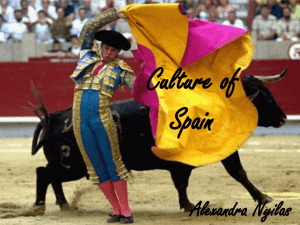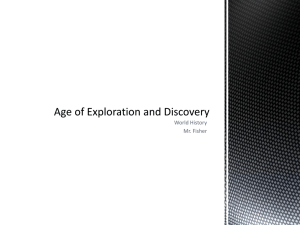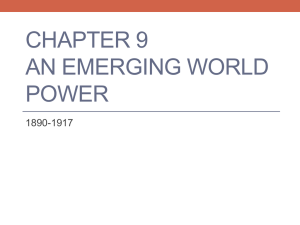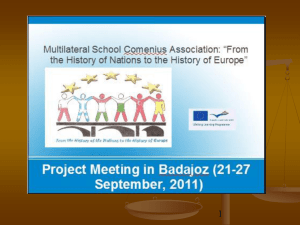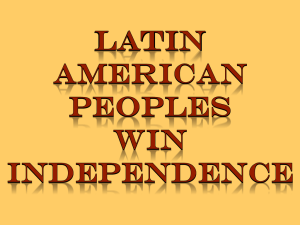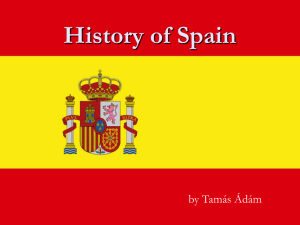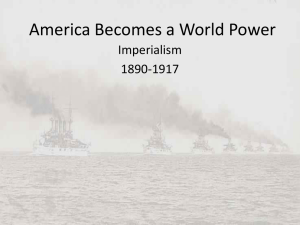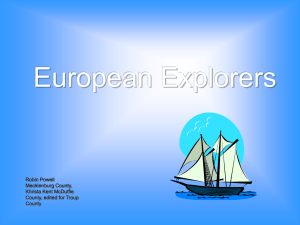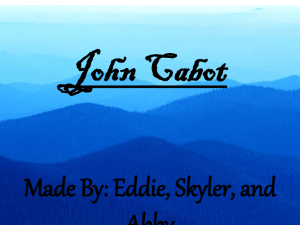The-Age-of-Exploration
advertisement
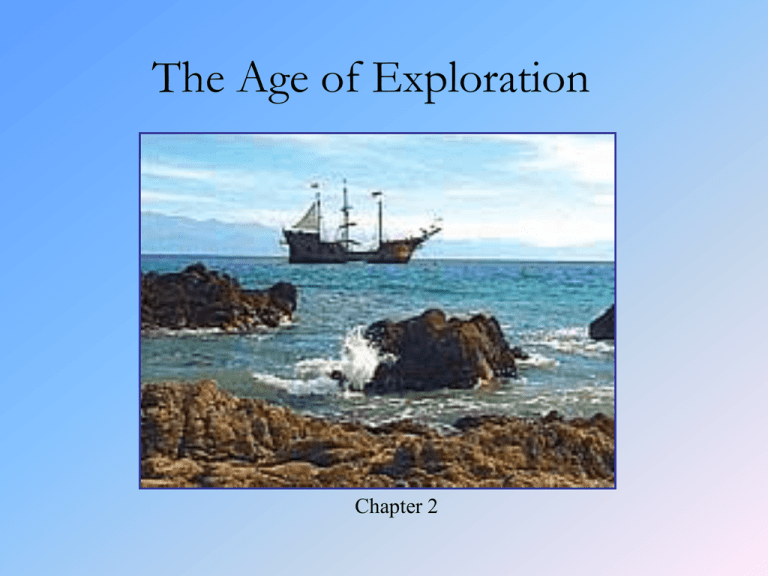
The Age of Exploration Chapter 2 Essential Questions 1. What were the three main motives for exploration? 2. Which explorers and countries were most noteworthy during this time? 3. What resulted from the voyages? Discussion Questions: Why was Europe interested in the Asia? What was the major dilemma in getting what they wanted? Europe wanted to trade in Asia, but hated and was afraid of Muslims in between them. No land or routes to trade around them yet and the Muslims would only trade Asian goods with Italy. What were the three motives for exploration? 1. God: Wanting to Christianize heathens (especially Muslims), cultural superiority, “white man’s burden.” *Like U.S. Imperialism 2. Glory: Spirit of adventure and curiosity during renaissance, fame, nationalism. *Manifest Destiny, Turner thesis 3. Gold: Rulers who trade with Asia get rich and powerful. Merchants who sell Asian goods in Europe make a lot of money. *Trade today Previously unknown Asian goods in high demand since Crusades. What made exploration possible? Technology: Smaller, sturdy ships called caravels with a smaller crew. More accurate maps Mariner’s compass Weapons: Cannons and guns. How did the Pope keep Spain and Portugal from fighting over newly discovered lands? Line of Demarcation: Spain tells Pope about discovery. Pope divides non-Christian world between Portugal and Spain so they don’t fight. Spanish Exploration Columbus Explain what Columbus did in 1492 Discovered America: Italian navigator sailing for Spain and seeking westward route to Asia. Thought Caribbean was Asia. Took Indians to Spain. Took colonist back to America. Arrested after colonies mismanaged. Cabot and Vespucci followed to N. America. Explain what Magellan did in 1519 First to circumnavigate the world Sailed west from Spain, cut through S. America at the Straight of Magellan to Pacific, sailed and starved for one month to Asia. Magellan dies in Philippians. Crew finishes without him. Portuguese Exploration Vasco da Gama What do you know about Portuguese exploration? 1. Small country with big interest. Prince Henry the Navigator spends his own money on expert group to secretly prepare a crew. 2. Set up trade and colonies on east coast of Africa. Used cannons to negotiate trade rights with locals. 3. Dias and da Gama = India. Kick out Muslims, set up trade rights with locals. 4. Competition with Italy for Asian goods means cheaper items for Europeans, demand goes up, Portugal makes money. 5. They had nothing to trade to Asia, must pay in gold. Not powerful enough to colonize Asia, like they did in the Central and South America. The American Colonies Emerge Spain establishes an American empire, devastating native populations. England forces the Dutch from North America and establishes thirteen colonies. Malinche, a slave fluent in Maya and Aztec, served as interpreter for the conqueror Hernando Cortés. NEXT Section 2 Spain’s Empire in the Americas Throughout the 1500s and 1600s, the Spanish conquer Central and portions of North America. NEXT SECTION 2 Spain’s Empire in the Americas The Spanish Claim a New Empire Cortés Subdues the Aztec • Conquistadors (conquerors)—Spanish explorers, seek gold, silver • 1519 Hernándo Cortés leads army into Americas, claims land for Spain • Aztec dominate region; Nahua people who resent Aztec join Cortés • Montezuma thinks Cortés a god; gives him share of Aztec gold • In 1520 Aztec rebel; in 1521 Spanish and their allies defeat Aztec • Cortés founds Mexico City, New Spain colony on Tenochtitlán ruins Map Continued . . . NEXT SECTION 2 continued The Spanish Claim a New Empire Spanish Pattern of Conquest • Spanish settlers mostly men, called peninsulares; marry native women • Mestizo—person of mixed Spanish and Native American ancestry • Landlords use encomienda—force natives to farm, ranch, mine • Priests object, encomienda abolished; Africans brought as slaves NEXT SECTION 2 The Conquistadors Push North Other Countries Explore North America • England, France, Netherlands sponsor voyages in 1500s and 1600s Map Exploring Florida • Juan Ponce de León discovers and names La Florida (1513) • Pedro Menéndez de Avilés expels French, founds St. Augustine (1565) Settling the Southwest • In 1540, Francisco Vásquez de Coronado leads expedition to Southwest • Pedro de Peralta, governor of New Mexico, Spain’s northern holdings • He helps found Santa Fe (1609–1610); several missions built in area Image NEXT SECTION 2 Resistance to the Spanish Conflict in New Mexico • Priests convert many Native Americans, try to suppress their culture • In 1670s Spanish force natives to pay tribute, do labor for missions Image Popé’s Rebellion • Pueblo religious leader Popé heads uprising in New Mexico (1680) • Pueblo destroy Spanish churches, execute priests, force Spanish out • Spanish armies regain area 14 years later NEXT Objectives • Describe the religious and economic conflicts in Europe during the Reformation. • Explain why European powers continued to search for a new route to Asia. • Describe the outcome of the search by explorers John Cabot and Henry Hudson for a northwest passage around the Americas. Terms and People • mercantilism – a system that held that colonies existed to make the home country wealthy and powerful • John Cabot – an Italian explorer who disappeared while on his second voyage to find a northern route to Asia • northwest passage – a hypothetical sea route from the Atlantic to the Pacific that passed through or around North America • Henry Hudson – an English explorer who attempted to find a northwest passage How did conflicts in Europe spur exploration in North America? As the appeal of the Reformation increased, the split between the Catholics and the Protestants increased religious and economic tensions in Europe. Catholics Protestants The Reformation caused religious tensions that inflamed existing rivalries among the nations of Europe. Nations did not feel that they could depend on their allies to protect them. By 1530, the rulers of Sweden, Denmark, and several European states had split with the Roman Catholic Church. They set up Protestant churches in their countries. Swiss thinker John Calvin influenced the development of Protestant churches in France, Switzerland, Scotland, and the Netherlands. In England, King Henry VIII joined the side of the Protestants when he sought to divorce his wife, Catherine of Aragon. The pope refused to annul the king’s marriage, so Henry broke with the Catholic church. He set up a Protestant church and named it the Church of England. King Henry VIII died in 1547, and his son ruled only briefly before he died, too. The throne passed to Mary I, who wanted to restore the Catholic Church in England. But Mary died in 1558, and Elizabeth I, a Protestant, took the throne. Queen Elizabeth I At this time, Spain and England were rivals because: King Philip II of Spain wanted to make England a Catholic nation again. The English were raiding Spanish ships for gold from the Americas. England was helping Holland, a Spanish province, try to win its independence. In 1588, King Philip sent 130 ships to England, hoping to force Queen Elizabeth from the throne. English ships met the Spanish ships off the coast of France and sank half of them. Spain’s defeat changed the balance of power in Europe. Spain’s control of the seas was weakened, so England and France were able to found colonies in the Americas. England funded an exploration led by John Cabot. Cabot thought a more northern route to Asia would be easier than the route Christopher Columbus had tried. • During his first trip, in 1497, he explored the region around Newfoundland. • During Cabot’s second trip, in 1498, his ships disappeared without a trace. Europeans soon realized the lands Cabot reached were not Asia, and they financed voyages to the new regions. Explorers from England, France, and Holland set out to find a northwest passage. The Search for a Northwest Passage Giovanni da Verrazzano • In 1524, this Italian explorer sailed for France, exploring the Atlantic coastal region from North Carolina to Newfoundland. • He found the mouth of the Hudson River and New York Bay. Jacques Cartier • This French explorer made three trips to North America for France. • He discovered the St. Lawrence River and explored it as far as present-day Montreal. English explorer Henry Hudson made four voyages in search of a northwest passage. After two unsuccessful voyages, Hudson’s English backers gave up on him. However, in 1609, the Dutch financed his third voyage, during which he reached New York and explored the river that today bears his name. In 1610, the English sponsored Hudson’s fourth voyage, during which his ship got stuck in the icy waters of Hudson Bay. In the spring of 1611, his irate crew mutinied and set him, his son, and several crew members adrift in a small boat. Hudson was never heard from again. After Hudson, European countries shifted their focus from finding a northwest passage to exploring the land itself. Europeans began to consider exploiting the resources of the land for profit. At the time, European leaders supported an economic theory called mercantilism. By establishing colonies, European nations could increase their own power and wealth.



